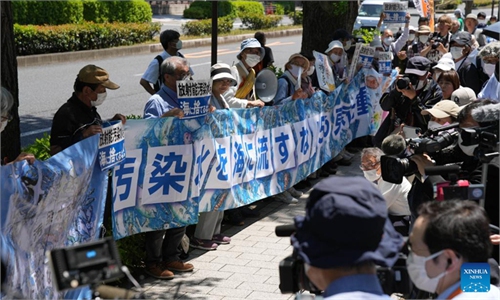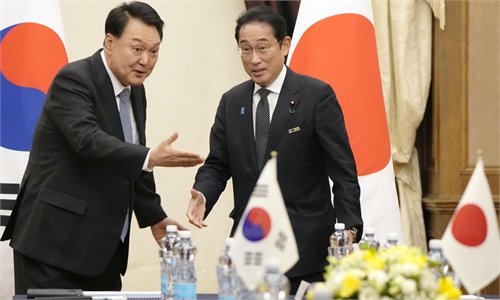Japan cannot use IAEA report to justify ocean dump of nuclear-contaminated wastewater

Japan's dangerous move.Illustration:Liu Rui/GT
Several days ago, the International Atomic Energy Agency (IAEA) published its review of Japan's plan to discharge the treated water from the Fukushima Daiichi Nuclear Power Station, which was badly damaged in the severe earthquake and tsunami in 2011. But in the foreword, IAEA Director General Rafael Grossi made a special effort to emphasize that the report is neither a recommendation nor an endorsement of Japan's policy.To put it more straightforwardly, the question of how best to dispose of the nuclear-contaminated wastewater remains.
Since 2011, Tokyo Electric Power Company (TEPCO) has been cooling the ruins of the melted reactors by pouring water over them. More than a decade later, over one million tons of the tainted water has accumulated, stored in over 1,000 tanks near the plant. It contains a variety of radioactive particles such as cesium, lithium, strontium and tritium - all of which pose a danger to human health.
In April 2021, the Japanese government approved TEPCO's plan to discharge the waste water into the sea, citing a lack of space for the storage tanks. According to its argument, the Advanced Liquid Processing System (ALPS) can remove most of the radionuclides, except tritium, and that it is common for nuclear plants to discharge cooling water that contains tritium.
This raises, first and foremost, a question: Is Fukushima just an ordinary nuclear power plant? At Fukushima, the reactors are broken, meaning there may very well be cracks. When water is directly poured over them, there is a good chance it will wash away radionuclides. In a functioning nuclear power plant, water does not come into direct contact with radioactive matter in the reactor. Not acknowledging Fukushima's special risk is dishonest and dangerously misleading.
Another question is how reliable ALPS is. In 2018, TEPCO admitted that 80 percent of its treated water contained dangerous radionuclides, well above the safe level required for ocean discharge. Then it was reported in 2020 that 72 percent of the water in the tanks needed to be re-treated. As recent as last month, South Korean experts who were on a routine visit to Fukushima learned that ALPS had experienced eight faults since 2013. There were samples showing that the treated water still contained a high concentration of radioactive particles that exceeded international safety standards.
Biomagnification is also a factor that must be considered. Even if radionuclides are within certain standards in the treated water, they can be transferred from one organism to another along the food chain. If a small shrimp carries even 0.0000001 mg of radioactive substances in its body, when 1,000 of them are eaten by a small fish, the concentration level rises to 0.0001 mg. Then, when bigger fish eat the smaller ones, it will eventually become a dish on the table. Humans, as the apex predator, are at a much higher risk.
The Japanese government's hasty decision on ocean discharge bears multiple risks for industries and the health of people around the Pacific rim. The IAEA report is only one of many steps that should be taken before the final choice can be made. Japan still needs to conduct good-faith consultations with international stakeholders and bring in more independent scientists from other parties to study the issue in a thorough way. As a country with a painful experience of nuclear explosion, Japan should understand better than anyone else the disastrous consequences when nuclear substances are not handled in a proper way.
The author is a commentator on internationals affairs, writing regularly for Xinhua News, Global Times, China Daily, CGTN etc. He can be reached at xinping604@gmail.com.


